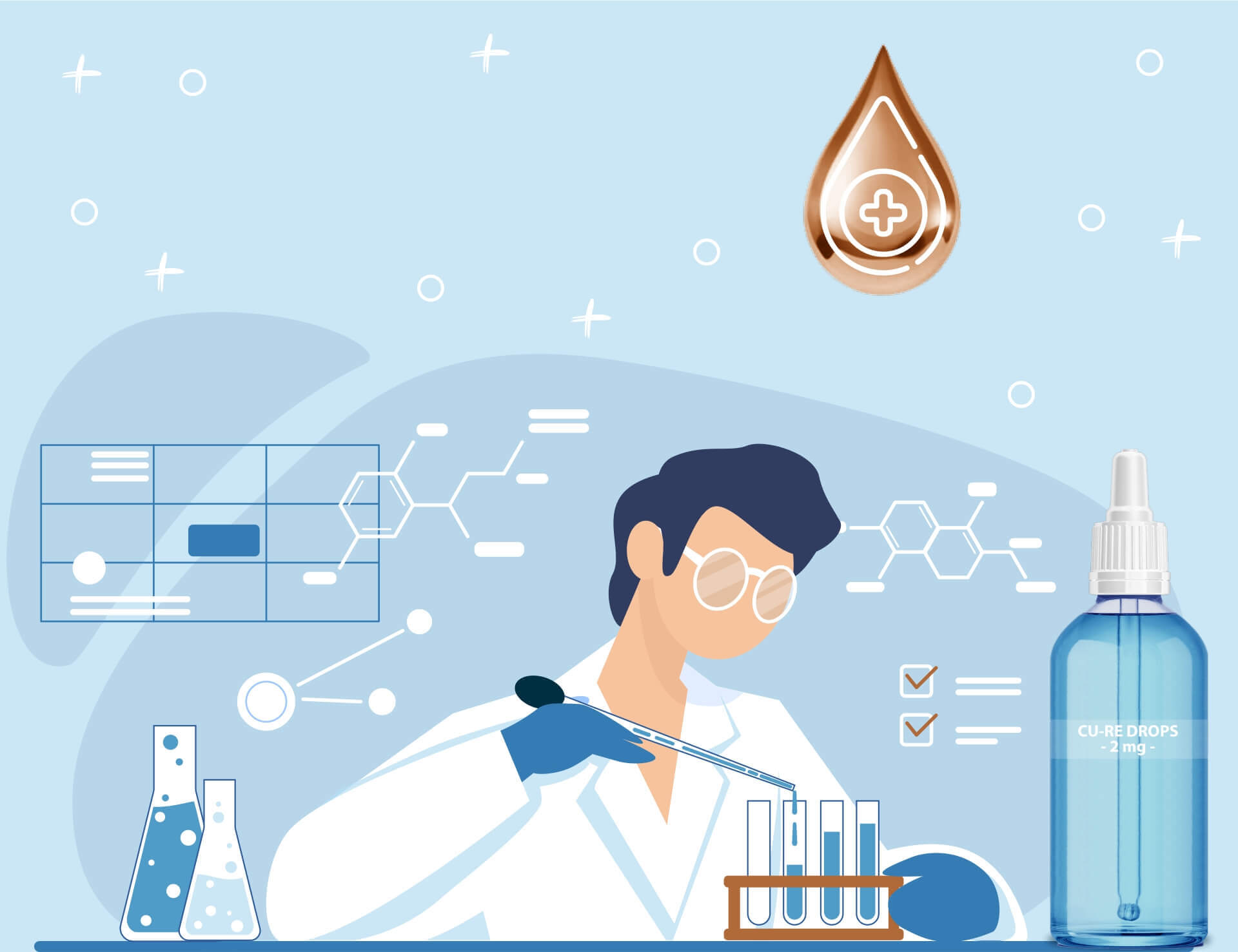The importance of copper’s role in the human body cannot be overstated. Copper is an essential element, meaning the body cannot synthesize it, thus it definitely requires external intake.
Ancient history
Historical retrospectives often begin with:
“Even the ancient Egyptians…”
However, when considering the physiological significance of copper, we need to turn the wheel of time back a bit further… by roughly 2.5 billion years.
Even then, anaerobic organisms such as cyanobacteria used copper-dependent enzymes for photosynthesis. And thus, an oxygen-rich atmosphere was formed. Then there was the oxygen catastrophe, aerobic organisms developed, we learned to utilize oxygen, and humans appeared. In a nutshell.

Why should we supplement with copper?
Copper is one of the most important elements in human physiology:
Firstly, because our energy production relies on electro(n)motors – namely, the mitochondria – which trace back to cyanobacterial ancestors. The once photosynthesis-related copper-dependent processes have transformed and now aid energy metabolism in an aerobic environment. Copper appears at multiple stages of the electron transport chain (complexes III and IV), notably in cytochrome c oxidase.
Secondly, it coordinates the processes of reactive substances such as oxygen and iron. Copper is responsible for ensuring that:
- an adequate amount of hemoglobin is produced in the body (ferrochelatase activity)
- iron can be transported in the correct form (Fe2+ → Fe3+) (hephaestin – ferroxidase activity)
- the oxidative by-products produced during the hazardous operation of cellular respiration are kept under control by antioxidant mechanisms (glutathione, ceruloplasmin, superoxide dismutase, catalase)

These are “just” the copper-dependent processes in the human body that are essential for life. In total, more than 30 enzymes have been identified in which copper plays an indispensable role in their formation or activity.
For instance, these include:
- Tyrosinase, which is a crucial enzyme in melanin production and is responsible for maintaining skin and hair color,
- Diamine oxidase, which is essential for the breakdown of histamine,
- Dopamine-β-hydroxylase, which is a key element in the production of norepinephrine (noradrenaline).
Additionally important is the:
- synthesis of collagen,
- quantity and activity of white blood cells,
- cholesterol levels,
- carbohydrate metabolism,
- synthesis of thyroid hormones and nearly all components of the endocrine system
Symptoms of copper deficiency
The symptomatic and diagnostic manifestation of copper deficiency is quite illustratively presented by the list compiled over the past years, which is still not exhaustive:
- fatigue, exhaustion
- irritability
- adrenal fatigue
- hypothyroidism
- nausea
- anxiety
- despair, hopelessness
- uncontrollable mind
- panic attacks, paranoia
- feelings of apathy and despondency
- depression
- headaches
- hair loss and/or graying of hair
- brain fog
- reduced immunity
- concentration and memory problems
- negative thoughts
- personality changes
- decreased libido
- OCD (Obsessive-Compulsive Disorder), ADHD (Attention Deficit Hyperactivity Disorder)
- craving for chocolate
- anemia
- allergies and sensitivity to mold
- insomnia
- schizophrenia
- PMS (Premenstrual Syndrome)
- constipation
- mood swings
- Candida fungal infections
- joint pain
- infertility
- hypoglycemia
- headaches
- decreased metabolism
- confusion, disorientation
- reduced self-awareness
- pseudo bipolar disorder
- cancer
The real importance of copper deficiency should be considered with the understanding that:
-> If copper plays a significant role in the human energy system, then it can be involved, directly or indirectly, in EVERY illness and symptom!
Why is there not enough copper in our bodies?
The drastic reduction in copper levels coincided, as did most drastic changes in human nutrition, with the era of the Industrial Revolution and the proliferation of food processing.
The diminished nutrient content in the soil, changes in animal husbandry practices, and the use of potential copper-binding pesticides have induced serious shifts in the balance of micronutrients. Even animal liver, which is a top source of copper, has experienced a reduction in its copper content.
- Australian livestock owners have reported drastic decreases in copper levels, which affected not only sick animals.
- Matt Blackburn, the founder of MitoLife, also reported on a Texan organic livestock farm where post-biopsy they practically found zero concentration of copper.
- Mineral researcher Morley Robbins encountered similar findings.

How much copper do we need?
Nothing in the body is constant, thus the intake of copper is not a one-size-fits-all, single-variable equation. The excretion, retention, quantity in the blood, and form of copper can be determined by a range of physiological and pathological factors.
These parameters are also dependent on environmental influences and an increasingly broad range of copper antagonistic elements such as:
- acute and chronic stress
- excessive consumption of zinc
- presence of heavy metals, halogens
- overuse of chelators
- processed foods
- micronutrient imbalance
- oxidative stress
- iron metabolism disorders…and the list could continue…
Copper deficiency can also be caused by:
- liver function disorders
- impaired bile production and excretion
- malabsorption
- gastric surgery
- inflammatory bowel disease
- cystic fibrosis
- celiac disease
- parenteral nutrition
- jejunal enteral nutrition
Despite these factors, health organizations have attempted to standardize average intake amounts. The recommended daily allowance (RDA) established since 2001 is based on three similar studies by the same researchers, not taking into account the aforementioned factors affecting copper requirements. Most countries recommend a daily intake amount varying slightly around 0.8-1mg.
Reality, however, is more complex as copper intake must follow a PERSONALIZED approach in EVERY CASE, but a minimum of 5-15 mg per day can lead to long-term improvements in health.
Is copper safe?
The official recommendations generally set the upper safe limit of copper intake at 10mg per day. No scientific literature was cited to support this threshold.
The topic of toxicity is complex, but its essence can be summarized as the existence of what is called primary and secondary toxicity. While the former is associated with the intake of high quantities, the latter refers to disturbances in copper metabolism due to genetic or toxicological reasons.
Primary toxicity is straightforward. Copper intake is safe up to about 20,000mg. Beyond this point (20 grams!), people begin to succumb to the effects, as evidenced by case descriptions from suicide attempts. However, there have been individuals who have survived the intake of 100,000mg (yes, 100 grams) of copper sulfate. Thus, everyone is advised to be mindful not to consume 20,000 times or more than the official recommendation to avoid serious harm.
Secondary toxicity does not depend on intake but rather results from a disruption in the body’s copper regulation and transport. While copper accumulates in certain tissues (and fails to fulfill its role), other areas may suffer from severe copper deficiency. Key players here are genes, oxidative stress, expressed copper transport proteins (chaperones), and unassembled copper-dependent enzymes.
The problem arises when experts conflate the two, believing that ingested copper amounts are correlated with copper accumulation in the nervous system or liver. However, the latest evidence suggests that high copper intake may actually help initiate the functioning of copper regulation, thereby utilizing the copper that has accumulated in what are considered toxic amounts in certain organs.
This misunderstanding is further compounded by profit interests. Well-established diagnostic procedures based on entrenched dogmas, such as blood tests or hair analysis, are unable to determine why and in which organ there would be excess copper. These procedures have practical uses but are not central to determining copper intake.
The recipe for chronic copper deficiency and a sick society
- There is a superficially developed recommendation for dietary and supplemental intake…
- Add to this the drastically reduced amount of copper in the food supply…
- Season it with elements of the Western lifestyle that decrease copper levels…
- Possibly sprinkle in some malabsorption issues…
- And for a final garnish, add expert opinions and diagnostic policies that demonize copper…
And thus, you have the recipe for chronic, population-wide copper deficiency, along with its vivid list of diseases and symptoms.

Takeaway
The significance of functional and lifestyle-related copper supplementation must certainly be reevaluated, and practical solutions should be personalized and integrated into everyday life.
Reference:
- Kaplan & O’Halloran, 1996
- Crichton & Pierre, 2001
- Turlund et al., 2001
- Leung et al., 2004
- Johnson, 2004
- Vashchenko, 2013
- Robbins, 2021
- Hommel, 2022





